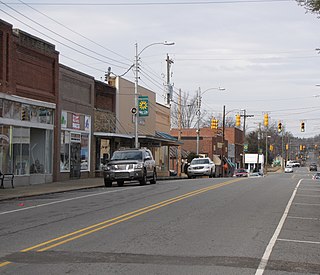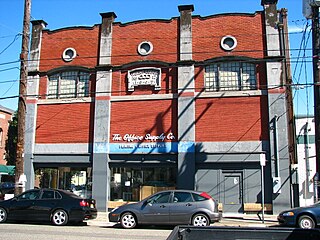
Siler City is a town in western Chatham County, North Carolina, United States. As of the 2020 census, the town's population was 7,702.

The West Raleigh Historic District in Raleigh, North Carolina is a national historic district listed on the National Register of Historic Places in 2003. Located 1.5 miles (2.41 km) west-northwest of the State Capitol, the district encompasses approximately 332 acres (134 ha). Neighborhoods in the district include: Bedford Heights, Bagwell, Blue Moon Ridge, College Crest, Fairmont, Forest Hills, Harris-Chamberlain, and Wilmont. Most homes in these neighborhoods are one-story and were constructed between the 1930s to 1950s. While the district is mostly residential, churches and commercial buildings are common along Hillsborough Street.
Crutchfield Crossroads is an unincorporated community in northwestern Chatham County, North Carolina, United States, north of the town of Siler City. Crutchfield Crossroads is commonly defined as the area in and around the rural intersection of Silk Hope-Liberty Road. and Siler City- Snow Camp Road. At the intersection of the two roads, there are some stores, but other than that the entire community is agricultural. Children living in this area attend schools in Silk Hope and Siler City.

Historic Oakwood is a neighborhood in downtown Raleigh, North Carolina, United States, on the National Register of Historic Places, and known for its Historic Oakwood Cemetery, its many Victorian houses and its location close to the Mordecai Plantation Manor. Located near the State Capitol and St. Augustine's Chapel, during the 19th century Historic Oakwood was home to prominent members of Raleigh's society. It is North Carolina's largest, intact 19th Century residential neighborhood and Raleigh's earliest white middle-class suburb. Unlike later suburbs, it developed lot-by-lot over time, instead of by platted sections. Its Victorian-era architectural styles include Second Empire, Queen Anne, and Italianate. Later infill brought the bungalow, the American Foursquare, American Craftsman style, and the Minimal Traditional house to the area.

The East Portland Grand Avenue Historic District, located in southeast Portland, Oregon, is listed on the National Register of Historic Places. The district includes approximately 20 city blocks on or near Southeast Grand Avenue on the east side of the Willamette River, roughly bounded on the south by SE Main Street, north by SE Ankeny Street, west by SE Martin Luther King Jr. Boulevard, and east by SE Seventh Avenue. Most structures in the district are commercial buildings rising two to three stories. Immediately to the west of the historic district is Portland's east side industrial area, and to the east are industrial and residential areas.

Harry Barton was an American architect in North Carolina.

Reid Street–North Confederate Avenue Area Historic District is a national historic district located at Rock Hill, South Carolina. It encompasses 22 contributing buildings in a middle-class residential section of Rock Hill. The district developed between about 1839 and 1935. Architectural styles represented include Victorian, Classical Revival, Queen Anne, and Bungalow. Notable buildings include the Steed House, Bynum House, Jenkins House, and Gross-Brock House, along with the separately listed White House.

Avery Avenue Historic District is a national historic district located at Morganton, Burke County, North Carolina. It encompasses 112 contributing buildings in a predominantly residential section of Morganton. They were built between about 1875 and 1935, and include representative examples of Colonial Revival, Bungalow / American Craftsman, and Late Victorian style architecture.

White Street–Valdese Avenue Historic District is a national historic district located at Morganton, Burke County, North Carolina. It encompasses 38 contributing buildings in a predominantly residential section of Morganton. They were built between about 1885 and 1936 and includes representative examples of Colonial Revival, Bungalow / American Craftsman, and Late Victorian style architecture.

The Jesse R. Siler House is a historic house at 115 West Main Street in Franklin, North Carolina. It is prominently sited at the base of the hill on which most of the city is located. A two-story log structure was built on this site c. 1819, and expanded between 1820 and 1830 by Jesse Siler, a prominent early settler of the area. It was modified significantly over the 19th century, most notably receiving a prominent Greek Revival tetrastyle portico. It retains many interior features from Siler's period of modification, exhibiting transitional Georgian-Federal styling in its mantels.

Claremont High School Historic District is a national historic district located at Hickory, Catawba County, North Carolina. The district encompasses 172 contributing buildings and 3 contributing structures in a predominantly residential section of Hickory. Most of the dwellings date from the late 19th through mid-20th century and include notable examples of Queen Anne, Colonial Revival, Tudor Revival, and Bungalow / American Craftsman style architecture. The Claremont High School was completed in 1925, and is a three-story, H-shaped, Neoclassical style school. The school was rehabilitated in 1986 as an arts and science center. Other notable buildings include Maple Grove, Shuler-Harper House (1887), Harvey E. McComb House (1889), (former) Corinth Reformed Church Parsonage (1895), Shuford L. Whitener House, Judge W. B. Councill House (1902), George W. Hall House, Carolina Park, Josephine Lyerly House, John L. Riddle House (1918), Marshall R. Wagner House (1938), David M. McComb Jr. House (1939), Arthur H. Burgess House (1940), and R. L. Noblin House (1950).
Hotel Hadley is a historic hotel building located at Siler City, Chatham County, North Carolina. It was built in 1907, and is two-story brick building with elaborate eclectic Victorian design elements. It served as the city's most desirable hotel and as Hadley's residence into the 1940s.
Gregson-Hadley House is a historic home located at Siler City, Chatham County, North Carolina. The house was built in approximately 1903, and is named for leading Siler City industrialist Julius Clarence Gregson, for whom it was built, and his brother-in-law Wade Hadley, to whom it was sold in 1920. It is a 1+1⁄2-story, richly decorated Queen Anne style dwelling. It features an exaggerated hip roof with several projecting gables, a pentagonal corner turret, and Eastlake movement wraparound porch.
Cadmus N. Bray House is a historic house located at 229 West Second Street in Siler City, Chatham County, North Carolina. James W. Turner, a local builder, constructed the house, and it remains a nearly unaltered representative of early 20th century architectural preferences in a small North Carolina rail town.
Siler City City Hall, also known as the Siler City Town Hall or Municipal Building, is a historic city hall located at Siler City, Chatham County, North Carolina. It is a two-story, T-shaped, seven-bay Colonial Revival style building. It is faced in granite and features a two-story, tetrastyle pedimented pavilion with a portico in antis. It is one of three extant Works Progress Administration buildings in Chatham County.
Siler City High School, also known as the Paul Braxton School, is a historic high school building located at Siler City, Chatham County, North Carolina. It was built in 1922, and is a two-story, T-shaped, five-bay brick school building with streamlined Art Deco design elements. It has a two-story-high auditorium wing. Also on the property are the contributing mid-1930s one-story brick woodworking shop building which now serves as a community center, a 1+1⁄2-story frame gymnasium begun in 1930, and an early 1930s dirt baseball field which was initially a football field.

Siler City Commercial Historic District is a national historic district located at Siler City, Chatham County, North Carolina. The district encompasses 45 contributing buildings in the central business district of Siler City. They are primarily one- and two-story brick buildings dated between 1897 and 1945. Located in the district is the separately listed Hotel Hadley. Other notable buildings include the Farmers Alliance Store (1909), Edwards-Wren Building (1906), Chatham Bank (1913), Wren Building (1912), former Siler City Furniture Building (1928), Colonial Revival style United States Post Office (1940), Phillips Office Supplies Building, Thorpe and Associates Building, and Fred C. Justice Building.
East Raleigh Street Historic District is a national historic district located at Siler City, Chatham County, North Carolina. The district encompasses 39 contributing buildings in a predominantly residential section of Siler City. They were built between about 1895 and 1945, and include representative examples of the Queen Anne and Tudor Revival architectural styles.

Trinity Historic District, also called Trinity Park, is a national historic district and residential area located near the East Campus of Duke University in Durham, North Carolina. The district encompasses 751 contributing buildings in a predominantly residential section of Durham. They were built between the 1890s and 1960 and include notable examples of Queen Anne and Bungalow / American Craftsman style architecture. Located in the district are the separately listed "Faculty Row" cottages: the Bassett House, Cranford-Wannamaker House, Crowell House, and Pegram House. Other notable buildings include the George W. Watts School (1917), Julian S. Carr Junior High School (1922), Durham High School (1923), Durham Alliance Church (1927), Trinity Avenue Presbyterian Church (1925), Watts Street Baptist Church (1925), Great A & P Tea Company (1927-1929), Grace Lutheran Church, and the former Greek Orthodox Community Church.

Pee Dee Avenue Historic District is a national historic district located at Albemarle, Stanly County, North Carolina. The district encompasses 87 contributing buildings and 1 contributing site in a predominantly residential section of Albemarle. They were built between about 1891 and 1947 and include notable examples of Queen Anne, Colonial Revival, and Bungalow / American Craftsman style residential architecture. Notable buildings include the Brown-Parker House, Crowell House, Lambert-Hughes-Ferrell House, W. Berly Beaver House (1929-1936), David Augustus Holbrook House (1929-1936), Langley-Holbrook House, William Thomas Huckabee, Jr., House (1947), Robert Lee Smith Family House, and Wade F. Denning House.
















